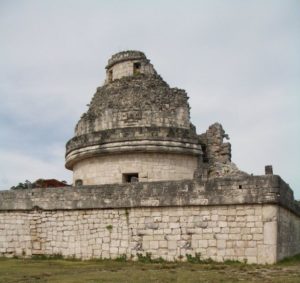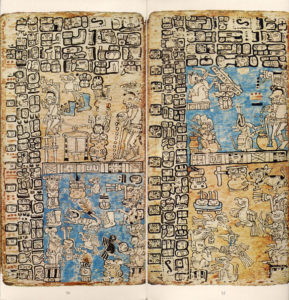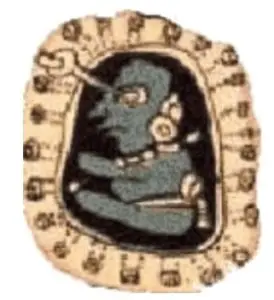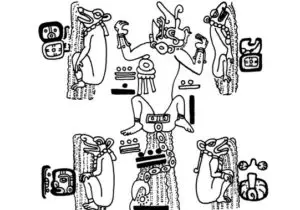Podcast: Play in new window | Download
Subscribe: Apple Podcasts | RSS
 One of the most popular tourist sites in all of Mexico is the ancient Maya city of Chichén Itzá. Just a short air-conditioned bus ride through scrub jungle from the resort towns of Cancún or Playa del Carmen, the ruins are visited by almost 1.5 million people annually. As one of the largest of the Maya cities, the ceremonial center of Chichén Itzá is dominated by several very large buildings and ceremonial complexes. One of the buildings that stands out is one unique to the Maya world because of its cylindrical shape. It is called in Spanish El Caracol – “The Snail” in English – because of the circular staircase inside the building. In the middle of the 20th Century the building acquired the nickname “The Observatory” because its collapsed roof and circular body are reminiscent of modern observatories and planetariums. Since the nickname became popular, writers and amateur archaeologists have turned the building into an actual ancient observatory not just based on its shape, but based on the fact, like most other ceremonial buildings, that it is aligned to celestial bodies. To this day the purpose of “The Observatory” at Chichén Itzá remains open to scholarly speculation. There is no doubt, though, that the ancient Maya were quintessential stargazers and compiled massive almanacs over hundreds of years to chart the movements of the sun, moon, stars and planets. In this podcast we will examine what the Maya knew about their physical world and how astronomy integrated into their religious beliefs.
One of the most popular tourist sites in all of Mexico is the ancient Maya city of Chichén Itzá. Just a short air-conditioned bus ride through scrub jungle from the resort towns of Cancún or Playa del Carmen, the ruins are visited by almost 1.5 million people annually. As one of the largest of the Maya cities, the ceremonial center of Chichén Itzá is dominated by several very large buildings and ceremonial complexes. One of the buildings that stands out is one unique to the Maya world because of its cylindrical shape. It is called in Spanish El Caracol – “The Snail” in English – because of the circular staircase inside the building. In the middle of the 20th Century the building acquired the nickname “The Observatory” because its collapsed roof and circular body are reminiscent of modern observatories and planetariums. Since the nickname became popular, writers and amateur archaeologists have turned the building into an actual ancient observatory not just based on its shape, but based on the fact, like most other ceremonial buildings, that it is aligned to celestial bodies. To this day the purpose of “The Observatory” at Chichén Itzá remains open to scholarly speculation. There is no doubt, though, that the ancient Maya were quintessential stargazers and compiled massive almanacs over hundreds of years to chart the movements of the sun, moon, stars and planets. In this podcast we will examine what the Maya knew about their physical world and how astronomy integrated into their religious beliefs.
 As the Maya were the only group in ancient Mexico with a fully developed written language, much of what we know about Maya astronomy and what they thought of their physical reality has come from firsthand sources. In addition to inscriptions made in stone found in the ruins of Maya cities, the ancient Maya also wrote in bark paper books called codices. In the few codices that survived the massive Maya book burning of Archbishop of the Yucatán Diego de Landa in 1562, we find astronomical tables and texts about the movements of celestial bodies. We also find pieces of the Maya creation myths and what the members of this civilization thought of the makeup of their physical world. In addition to the archaeological evidence of what the Maya thought in their own words, we have written accounts from the initial Spanish contact with descendants of the ancient Maya. Although classic Maya civilization collapsed five to six hundred years before the arrival of the Spanish, much of what was gleaned by the Spanish chroniclers at the time of first contact has been interpreted by scholars as being part of the unbroken chain of Mesoamerican belief systems passed down from antiquity and much of it reinforces what archaeologists have learned from studying ancient texts and inscriptions. It’s also important to note that the Maya had an advanced number system and were skilled at mathematics. They even developed the concept of zero, seemingly independent from the rest of the world in their jungle isolation. Their applications of math and written language to understanding their world helps us in the modern age understand what the Maya thought about their physical world and its relation to the cosmos.
As the Maya were the only group in ancient Mexico with a fully developed written language, much of what we know about Maya astronomy and what they thought of their physical reality has come from firsthand sources. In addition to inscriptions made in stone found in the ruins of Maya cities, the ancient Maya also wrote in bark paper books called codices. In the few codices that survived the massive Maya book burning of Archbishop of the Yucatán Diego de Landa in 1562, we find astronomical tables and texts about the movements of celestial bodies. We also find pieces of the Maya creation myths and what the members of this civilization thought of the makeup of their physical world. In addition to the archaeological evidence of what the Maya thought in their own words, we have written accounts from the initial Spanish contact with descendants of the ancient Maya. Although classic Maya civilization collapsed five to six hundred years before the arrival of the Spanish, much of what was gleaned by the Spanish chroniclers at the time of first contact has been interpreted by scholars as being part of the unbroken chain of Mesoamerican belief systems passed down from antiquity and much of it reinforces what archaeologists have learned from studying ancient texts and inscriptions. It’s also important to note that the Maya had an advanced number system and were skilled at mathematics. They even developed the concept of zero, seemingly independent from the rest of the world in their jungle isolation. Their applications of math and written language to understanding their world helps us in the modern age understand what the Maya thought about their physical world and its relation to the cosmos.
 The Maya practiced naked-eye astronomy, as no instruments were used to view the heavens except for crude hollowed-out pointing sticks held close to the eye. Certain buildings in ancient Maya cities were arranged to serve as astronomical observatories. The set up usually consisted of a pyramid oriented due east which was used in conjunction with three temples situated to give the observer on the pyramid’s staircase points of reference to view sunrises and sunsets and thus determine the occurrences of the equinoxes and solstices. Archaeoastronomers and modern-day scholars who study astronomical alignment of buildings or settlements often call this “sacred geometry.”
The Maya practiced naked-eye astronomy, as no instruments were used to view the heavens except for crude hollowed-out pointing sticks held close to the eye. Certain buildings in ancient Maya cities were arranged to serve as astronomical observatories. The set up usually consisted of a pyramid oriented due east which was used in conjunction with three temples situated to give the observer on the pyramid’s staircase points of reference to view sunrises and sunsets and thus determine the occurrences of the equinoxes and solstices. Archaeoastronomers and modern-day scholars who study astronomical alignment of buildings or settlements often call this “sacred geometry.”
With their advanced knowledge of math and ability to make keen observations, the ancient Maya never thought of the earth as a ball moving in an endless Universe. The Maya thought that the earth was the center of all creation and that it existed on a flat plane instead of a sphere spinning through space. The earth extended into infinity on this endless plane with layers below making up the underworld and layers above making up the heavens. While some authors claim the Maya believed there were four corners to the earth, there is nothing uncovered so far to indicate that they believed that the earth plane ended, only that it had 4 directions and that somewhere away from the center of the earth plane off into those directions were symbolic jaguars called bacabs holding up the  sky. Each jaguar corresponded to a color: east-red; north-white; west-black; south-yellow. We can see an illustration of the four jaguars in the Codex Madrid, one of the surviving bark painted books described earlier. In these four directional areas were also four ceiba trees topped with birds of the appropriate colors. From inscriptions found at the ancient cities of Palenque and Piedras Negras, it is also believed that a fifth green tree was found in the center of the earth plane. It is unknown if the trees were there to help hold up the heavens or as pathways to the heavens. It is also unknown whether or not the Maya felt they could know the exact location of the gigantic ceiba tree in the center of the earth plane, or even if they had interest in looking for it. We do know that the ceiba was looked upon by the ancient Maya as a tree of abundance from which food for mankind first came. In the Maya cosmology, Earth has often been symbolized as a gigantic crocodile or lizard, sometimes with two heads, which has led some to write that the Maya believed that the earth traveled on the back of a crocodile or lizard, but this would not fit in with the structural or spatial view the Maya had of their universe. To them, the earth was stationary and fixed and only the objects in the heavens moved.
sky. Each jaguar corresponded to a color: east-red; north-white; west-black; south-yellow. We can see an illustration of the four jaguars in the Codex Madrid, one of the surviving bark painted books described earlier. In these four directional areas were also four ceiba trees topped with birds of the appropriate colors. From inscriptions found at the ancient cities of Palenque and Piedras Negras, it is also believed that a fifth green tree was found in the center of the earth plane. It is unknown if the trees were there to help hold up the heavens or as pathways to the heavens. It is also unknown whether or not the Maya felt they could know the exact location of the gigantic ceiba tree in the center of the earth plane, or even if they had interest in looking for it. We do know that the ceiba was looked upon by the ancient Maya as a tree of abundance from which food for mankind first came. In the Maya cosmology, Earth has often been symbolized as a gigantic crocodile or lizard, sometimes with two heads, which has led some to write that the Maya believed that the earth traveled on the back of a crocodile or lizard, but this would not fit in with the structural or spatial view the Maya had of their universe. To them, the earth was stationary and fixed and only the objects in the heavens moved.
 The Maya believed that the heavens were divided into seven sections and symbolized by thirteen steps in which certain gods resided. Six steps ascended in the east, and six descended in the west, with one step or platform at the top. Much of what the Maya saw in the skies was allegorical or based on myths and fables, but most of why these ancient people tracked the movements of the celestial bodies were for practical uses. Like many other ancient peoples, they relied on the heavens for clues as to when to plant and when to start the harvesting process. The Maya also looked skyward for other reasons we might consider more astrological instead of astronomical, like when to go to war, for example. The planets were called “stars that travel” and not seen as spherical worlds made of rock orbiting the sun. The sun, of course, was the most important heavenly body, and the Maya tracked it and recorded it, and predicted its eclipses with high accuracy. The rulers of the Maya world co-opted the sun and often Maya kings were shown alongside the powerful sun symbol. The sun was not considered to be a star, but a separate type of entity. In the Maya creation story, the sun and the moon were the first people on the earth. The sun was a great hunter and the creator of music and poetry. The moon was a weaver, a protector of plants and later the patroness of childbirth. She had a fight with the sun and lost one of her eyes and that is why her light is so much dimmer than the sun’s. The ancient Maya often bestowed honorific titles on the sun and moon, such as “lord” or
The Maya believed that the heavens were divided into seven sections and symbolized by thirteen steps in which certain gods resided. Six steps ascended in the east, and six descended in the west, with one step or platform at the top. Much of what the Maya saw in the skies was allegorical or based on myths and fables, but most of why these ancient people tracked the movements of the celestial bodies were for practical uses. Like many other ancient peoples, they relied on the heavens for clues as to when to plant and when to start the harvesting process. The Maya also looked skyward for other reasons we might consider more astrological instead of astronomical, like when to go to war, for example. The planets were called “stars that travel” and not seen as spherical worlds made of rock orbiting the sun. The sun, of course, was the most important heavenly body, and the Maya tracked it and recorded it, and predicted its eclipses with high accuracy. The rulers of the Maya world co-opted the sun and often Maya kings were shown alongside the powerful sun symbol. The sun was not considered to be a star, but a separate type of entity. In the Maya creation story, the sun and the moon were the first people on the earth. The sun was a great hunter and the creator of music and poetry. The moon was a weaver, a protector of plants and later the patroness of childbirth. She had a fight with the sun and lost one of her eyes and that is why her light is so much dimmer than the sun’s. The ancient Maya often bestowed honorific titles on the sun and moon, such as “lord” or  “lady”, or “our mother,” or “our grandfather.” In art and in inscriptions, the sun’s path in the sky was often illustrated by a double-headed serpent. The planets, while tracked and catalogued meticulously by the astronomer-priests, also had their allegorical sides to them. Saturn and Jupiter were two types of falcons. The planet Mars was considered to be twin monkeys. Venus, which was probably the most important planet to be studied by the ancient Maya, was associated with the feathered serpent god Quetzalcoatl. The famous “Venus Tables”, an 8-year almanac of the planet, can be found in the Dresden Codex, with a detailed description of the 584-day average Venus cycle which is very close to our modern-day astronomical observations. Venus, it seemed, also played important roles in fertility and warfare. So-called Venus cults existed throughout Mesoamerica, and not just in the Maya area. As it is the brightest star-like celestial body in the night sky, Venus is often conflated with the sun in some Maya imagery. Very little is known about how these ancient people regarded the planet Mercury. It has been loosely associated with an owl image, but not much else is known about how this planet fit into the Maya universe.
“lady”, or “our mother,” or “our grandfather.” In art and in inscriptions, the sun’s path in the sky was often illustrated by a double-headed serpent. The planets, while tracked and catalogued meticulously by the astronomer-priests, also had their allegorical sides to them. Saturn and Jupiter were two types of falcons. The planet Mars was considered to be twin monkeys. Venus, which was probably the most important planet to be studied by the ancient Maya, was associated with the feathered serpent god Quetzalcoatl. The famous “Venus Tables”, an 8-year almanac of the planet, can be found in the Dresden Codex, with a detailed description of the 584-day average Venus cycle which is very close to our modern-day astronomical observations. Venus, it seemed, also played important roles in fertility and warfare. So-called Venus cults existed throughout Mesoamerica, and not just in the Maya area. As it is the brightest star-like celestial body in the night sky, Venus is often conflated with the sun in some Maya imagery. Very little is known about how these ancient people regarded the planet Mercury. It has been loosely associated with an owl image, but not much else is known about how this planet fit into the Maya universe.
 As mentioned earlier, the Maya believed that the heavens had seven layers, so they did not think that the universe was infinite in an upward and outward direction as we do. In this contained space, existed the sun, the moon and planets along with the stars. To the Maya, the stars were metaphorically described as jaguar spots, flowers, fireflies and “the eyes of the night.” Like other peoples throughout the world, the ancient Maya saw constellations in the night sky. The Pleiades was thought to be a rattlesnake’s rattle called Tz’ab. Orion’s Belt was part of a turtle constellation. In Sagittarius they saw a gigantic fish-snake. In a strange coincidence, the people in the northern Maya area saw the constellation Scorpius as we see it, in the shape of a scorpion. The Milky Way holds a special place in the beliefs of the ancient Maya. To them it was the extension of the World Tree whose roots begin in the layers of the underworld and stretches from the earth plane to the heavens. When oriented in a north-south direction, the Milky Way makes a cross with the elliptical path of the sun. This cross is called the K’an and is very popular in Maya iconography. The center of this cross is where all creation began. The dark center of the Milky Way, called Xibalbá Be by the Maya and often referred to as “The Great Rift,” was also important in that it was seen as the pathway of souls to another world, a belief held by many other cultures.
As mentioned earlier, the Maya believed that the heavens had seven layers, so they did not think that the universe was infinite in an upward and outward direction as we do. In this contained space, existed the sun, the moon and planets along with the stars. To the Maya, the stars were metaphorically described as jaguar spots, flowers, fireflies and “the eyes of the night.” Like other peoples throughout the world, the ancient Maya saw constellations in the night sky. The Pleiades was thought to be a rattlesnake’s rattle called Tz’ab. Orion’s Belt was part of a turtle constellation. In Sagittarius they saw a gigantic fish-snake. In a strange coincidence, the people in the northern Maya area saw the constellation Scorpius as we see it, in the shape of a scorpion. The Milky Way holds a special place in the beliefs of the ancient Maya. To them it was the extension of the World Tree whose roots begin in the layers of the underworld and stretches from the earth plane to the heavens. When oriented in a north-south direction, the Milky Way makes a cross with the elliptical path of the sun. This cross is called the K’an and is very popular in Maya iconography. The center of this cross is where all creation began. The dark center of the Milky Way, called Xibalbá Be by the Maya and often referred to as “The Great Rift,” was also important in that it was seen as the pathway of souls to another world, a belief held by many other cultures.
 While most of what the Maya knew about their world and the universe can be understood by us today, the decipherment of Maya writing is ongoing and new discoveries are constantly being made to further our current understanding of how the Maya saw the universe and their place in it. The jungle astronomer-priests continue to speak to us and teach us hundreds of years after the collapse of Maya civilization. Apparently, there is still more yet to be revealed.
While most of what the Maya knew about their world and the universe can be understood by us today, the decipherment of Maya writing is ongoing and new discoveries are constantly being made to further our current understanding of how the Maya saw the universe and their place in it. The jungle astronomer-priests continue to speak to us and teach us hundreds of years after the collapse of Maya civilization. Apparently, there is still more yet to be revealed.
REFERENCES (This is not a formal bibliography)
Echoes of the Ancient Skies: The Astronomy of Lost Civilizations by E.C. Krupp
Star Gods of the Maya: Astronomy in Art, Folklore and Calendars by Susan Milbrath
Time and Reality in the Thought of the Maya by Miguel Leon-Portilla
The Rise and Fall of Maya Civilization by J. Eric S. Thompson
Maya: The Riddle and Rediscovery of a Lost Civilization by Charles Gallenkamp

3 thoughts on “Maya Astronomy, the Flat Earth and the Infinite Universe”
Thank you, this is much appreciated!
Thank you for stopping by and taking the time to comment!
im Becky with a y